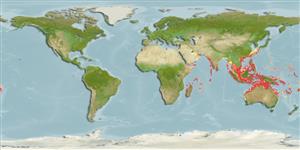Classification / Names
Common names from other countries
Main reference
आकार / वज़न / Age
Max length : 100.0 cm TL पुल्लिंग / अलिंग; (Ref. 55); common length : 50.0 cm TL पुल्लिंग / अलिंग; (Ref. 55); अधिकतम प्रकाशित वज़न: 7.9 kg (Ref. 4699); अधिकतम सूचित उम्र: 31 वर्षो (Ref. 46527)
Length at first maturity
Lm 57.6, range 54 - ? cm
पर्यावरण
; समुद्री; खारा प्रवाल-भित्ति संयुक्त; गहराई सीमा 12 - 100 m (Ref. 55)
जलवायु / सीमा
Tropical, preferred 27°C (Ref. 107945); 33°N - 33°S, 43°E - 178°W
वितरण
Indo-West Pacific: Persian Gulf and Arabian Sea to Fiji, north to southern Japan, south to Australia. This species has been frequently misidentified as Lutjanus sanguineus (Ref. 55). There are unsubstantiated reports of this species from off East Africa.
देश | ऐफ ऐ ओ क्षेत्र | Ecosystems | संयोग | भूमिका
Short description
पृष्ठीय रीढ़ (सम्पूर्ण): 11; पृष्ठीय सौफट रेज़ (सम्पूर्ण): 12-14; गुदा कांटा 3; ऐनल सौफट रेज़: 8 - 9.
IUCN Red List Status (Ref. 115185)
Threat to humans
Harmless
Human uses
मात्स्यिकी: उच्च वाणिज्य; आखेट मत्स्य: हां; जलजीवालय: व्यापारिक
अधिक जानकारी
सहयोगीयोतस्वीरेStamps, Coinsध्वनिसिगुयटिरारफ्तारतैरने के प्रकारगिल क्षेत्रOtolithsदिमागदृष्टि
साधन
Special reports
Download XML
इंटरनेट स्रोत
Estimates of some properties based on models
Phylogenetic diversity index
PD50 = 0.5000 many relatives (e.g. carps) 0.5 - 2.0 few relatives (e.g. lungfishes)
Trophic Level
4.5 ±0.5 se; Based on diet studies.
लौटाव
निम्न, न्यूनतम जनसंख्या दुगनी होने का समय 4.5 - 14 वर्ष। (K=0.12-0.18; tmax=12; Fec=5,000,000)
Vulnerability
Moderate to high vulnerability (50 of 100)
Price category
